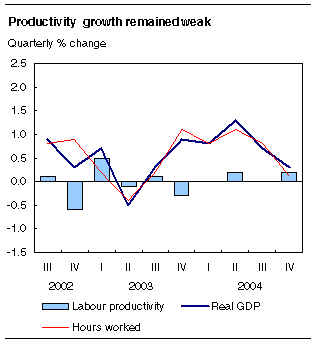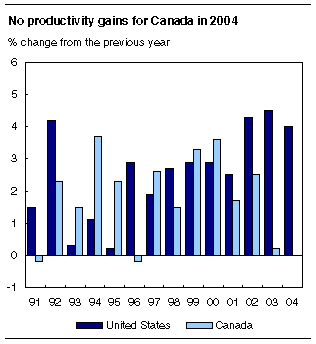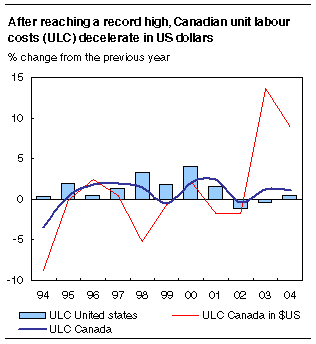
















 |
|
 |                |
Information identified as archived is provided for reference, research or recordkeeping purposes. It is not subject to the Government of Canada Web Standards and has not been altered or updated since it was archived. Please "contact us" to request a format other than those available.

|

Thursday, March 10, 2005 Labour productivity, hourly compensation and unit labour cost2004 and fourth quarter 2004In 2004, Canadian businesses recorded their worst performance in labour productivity growth in eight years as both economic activity, hit by the rising Canadian dollar, and the number of hours worked increased in tandem for a second year in a row. Productivity growth in Canadian businesses was a flat 0.0% last year. During the fourth quarter alone, productivity rose a marginal 0.2% from the third quarter. The gain was due almost entirely to growth in gross domestic product (GDP) as the number of hours worked edged up only 0.1%. 
Productivity is measured as the ratio of output for every hour worked. For example, it improves when GDP increases more rapidly than the number of hours worked. Productivity growth is a key factor determining the living standard of Canadians.
Labour productivity has been virtually flat for two consecutive years. Last year's growth was the smallest since 1996, while the increase in 2003 was only 0.2%. Canadian businesses had to cope with a 7.1% gain in the value of the loonie relative to the US greenback last year on the heels of a 10.8% gain the year before. Fourth quarter 2004: Output growth in the United States surpasses Canada'sProductivity grew faster among American businesses during the last three months of 2004 than it did among their Canadian counterparts because economic output in the United States increased at a faster rate. At the same time, the number of hours worked rose about 0.1% in both countries. In the United States, productivity increased 1.0% in the fourth quarter compared with the previous quarter. This was an improvement over gains of 0.8% in the second quarter and 0.4% in the third. During the past six quarters, the number of hours worked in the United States rose at an average of 0.3% per quarter. In Canada, however, the 0.1% increase in the fourth quarter halted a series of stronger increases than in the United States that started mid-way through 2003. The different productivity performance between the two nations was in growth of real GDP. Growth in output among American businesses surpassed that of Canadian businesses for the second consecutive quarter. In Canada, GDP growth in the business sector slowed to 0.3%, less than half what it was in the third quarter (+0.7%). The slowdown was due to a decline in exports of goods and services, which were down for a second consecutive quarter. On the American side, GDP growth slowed slightly from 1.1% to 1.0% between the third and the fourth quarter. Output in the United States has grown at rates higher or equal to 1.0% since the second quarter of 2003. The slight deceleration south of the border was due partly to a slowdown in exports and in consumer expenditures (mainly from a slowdown in car purchases) and the acceleration of imports. Annual 2004: Canadian firms had to adapt to soaring loonieProductivity gains in Canada and the United States went in opposite directions in 2004 because of their very different economic performances and labour market situations. Productivity in the United States in 2004 benefited from higher output and a smaller increase in hours worked than in Canada. In Canada, real GDP and hours worked grew at a similar pace, leaving Canadian productivity virtually unchanged. In Canada, where all the growth in employment was ascribed to full-time jobs, hours worked advanced 2.8%. Canada's job market performance compares favourably to that of the United States which experienced a 1.1% increase in hours worked. This was the first time in four years that the US labour market posted positive growth in hours worked. In addition, during the past two years, Canadian businesses were forced to adapt to a major realignment of world currencies, including the Canadian dollar. The 10.8% rise in the value of the loonie relative to the US greenback in 2003 was followed by a further 7.1% gain last year. Meanwhile, the American dollar lost ground not only against the Canadian dollar, but also against most "strong" European and Asian currencies. Consequently, American businesses experienced higher economic growth than Canada. They also registered their first increase in the number of hours worked in three years. In short, real GDP among Canadian businesses rose 2.9% last year, while the number of hours worked went up 2.8%. But in the United States, real GDP was up 5.1% while the number of hours worked rose only 1.1%. The result was flat growth in labour productivity in Canada, and a 4.0% gain south of the border. 
Unit labour costs in US dollars grew slowlyThe United States continued to have an advantage over Canada in unit labour costs in 2004, especially when the exchange rate was taken into account. The labour cost of producing one unit of output in the Canadian business sector rose 1.1% in 2004, nearly the same pace as in 2003. In contrast, unit labour costs in the American business sector edged up only 0.5% following two consecutive annual decreases. When the exchange rate is taken into account, American businesses were in an even more advantageous position. The lack of labour productivity gains in the Canadian business sector in 2004, combined with the higher Canadian dollar, resulted in an 8.8% gain in unit labour costs in Canada measured in US dollars. In contrast, unit labour costs in the United States rose just 0.5%. 
In 2003, unit labour costs in Canada, measured in US dollars, surged 13.6% to a record high, as the loonie rose 10.8% against the US dollar. Despite this deterioration in unit labour cost, Canada's exports rebounded 4.9% in 2004 following a 2.4% decline in 2003. Canadian businesses also took advantage of the dollar's strength to invest in machinery and equipment, on which they spent 9.4% more in 2004 than they did the year before. This was reflected in their sharply higher imports, which rose 8.2%. Available on CANSIM: tables 383-0008 and 383-0012. Definitions, data sources and methods: survey number 5042. A more comprehensive analysis, including additional charts and tables, is now available online in the Canadian Economic Accounts Quarterly Review (13-010-XIE, free). A new study entitled Canada/US Labour Productivity Revisions in Business Sector (11F0026MIE2005003, free) is also available online. From the Our products and services page, under Browse our Internet publications, choose Free, then National accounts. The first quarter 2005 data for Labour productivity, hourly compensation and unit labour cost will be released on June 9. To order data, contact Client Services (productivity.measures@statcan.gc.ca). For more information, or to enquire about the concepts, methods or data quality of this release, contact Jean-Pierre Maynard (613-951-3654; fax: 613-951-3292; maynard@statcan.gc.ca), Micro-economic Analysis Division.
| |||||||||||||||||||||||||||||||||||||||||||||||||||||||||||||||||||||||||||||||||||||||||||||||||||||||||||||||||||||||||||||||||||||||||||||||||||||||||||||||||||||||||||||||||||||||||||||||||||||||||||||||||||||||||||||||||||||||||||||||||||||||||||||||||||||||||||||||||||||||||||||||||||||||||||||||||||||||||||||||||||||||||||||||||||||||||
|
|
|